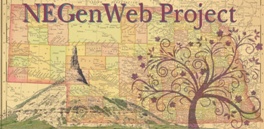
|
In the summer of 1868 William Peniston, from Yorkshire, England, and A.J. Miller, "an Easterner," partners in a road ranch at Willow Island (in what became Dawson County), acting on information that the Union Pacific would establish an important division point just west of the junction of the rivers, moved there and built a general store. By November the rails had crossed the North Platte River and the town of "North Platte" (the only city known to bear that name) became a reality. For a time North Platte was wild and lawless since the town sprang up overnight, and for the most part was peopled by construction crews, gamblers, saloon keepers, and their hangers-on. During construction it was said to have had a population of over 3,000 living primarily in tents and shacks, with only a few real buildings. The town had its quota of murders, lynchings, and drunken "broils" that went on around the clock. This era was short-lived as the railhead moved west the next summer, whereupon the majority of the town moved on to the next end-of-the-tracks town.
As a division point on the railroad as well as being located in the rich Platte valley, the town grew steadily. It incorporated as a village in 1873, became a second class city in 1875, and a first class city in 1910 when its population reached 4,793. By 1920 the population had more than doubled to 10,466, reached 17,180 by 1960, and was officially recorded as 24,479 by 1980. There were virtually no trees to be found when the town was new. After the Texas Trail moved west and cattle no longer ranged the streets, people fenced their yards and planted trees. Today the city's streets and numerous parks are well shaded.
Jeffers chose his home town of North Platte in which to build a "retarder" rail yard. This huge complex on the west edge of town has a receiving capacity for 1,400 cars. Completed in 1948, it required 51 additional miles of trackage and cost $3,500,000. Constantly updated and expanded, it is now the largest such facility in the world, representing an investment of $68 million. As many as 6,300 cars can be sorted per day with an average of 60 trains leaving the yard for destinations east, west, and south. North Platte also has the distinction of having the first lighted airfield in the United States. In 1921 a representative of the post office department asked the town to open an airfield for the use of pilots carrying transcontinental air mail. The department had no money for leasing land or building hangers, but promised that if the town would oblige them, it would be reimbursed as soon as Congress appropriated the funds. The town subscribed $45,000 in capital stock and obtained land just east of the bridge. Wooden hangers were built and the field (only a hay meadow) was leveled by hauling in dirt to fill the old buffalo wallows on its surface. The landing strip was then outlined by 100 kerosene lanterns hung on stakes driven into the ground. These lanterns had to be cleaned and filled daily and lighted each night. In February 1921 Jack Knight made his famous airmail night-flight, landing successfully on the "lighted air strip in the middle of Nebraska." Although the field remained a hay meadow for the next 20 years, some improvements were made and it continued to serve the country as a major link in aviation capable of landing planes after dark. In 1941 a concrete runway and electric lights were added. A terminal building was erected in 1952. Today, its longest runway measures 8,000 feet. (Incidentally, Congress never appropriated the money to pay the original stockholders.) During World War II our town became famous as the home of the "North Platte Canteen." With headquarters in the huge old unused dining room of the Union Pacific depot, hundreds of clubs and organizations (some from towns as far as 200 miles away) served countless tons of sandwiches, cakes, coffee, candy bars, and magazines to more than six million members of the armed forces. The canteen was open day and night for 51 months, frequently serving as many as 23 trains -- up to 8,000 service men -- in 24 hours. A grand reunion of people who worked at the canteen and the service personnel who appreciated this gesture of hospitality is planned for the fall of 1988.
North Platte hosted the first statewide celebration known as "NEBRASKAland Days" in 1968, the year following the state's centennial. This event has grown over the years to include a week-long festival of parades, rodeos, barbecues, shoot-outs, dances, carnivals, stage shows, and pow-wows. Thousands of Nebraskans and out-of-state visitors converge on the city for this annual extravaganza. Of course as far as North Platte is concerned, it all began back when Buffalo Bill (W.F. Cody) held his "Old Glory Blowout" to celebrate the Fourth of July back in 1882. Claimed by our town to be the first rodeo ever held, Cody had bucking broncos, buffalo riding, steer roping, and horse races and paid cash prizes to the participants. Due to the great success of the Blowout, Cody took his "Wild West Show" on the road the next year. He became a world-renown showman and North Platte's most famous citizen.
By Nellie Yost, 1505 West D, North Platte, NE 69101 ADDITIONAL MATERIAL: History of Lincoln County by Bare and McDonald, 1920. The American Historical Society Chicago and New York. Pictorial Atlas of Lincoln County, 1969 by Title Atlas Co., Minneapolis, MN. Data furnished by the Union Pacific Company, Omaha; Brochures compiled by the Chamber of Commerce, North Platte |
| Copyright NEGenWeb |
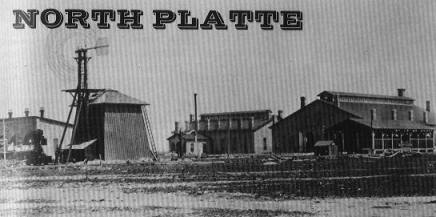 NORTH PLATTE --
LINCOLN COUNTY
NORTH PLATTE --
LINCOLN COUNTY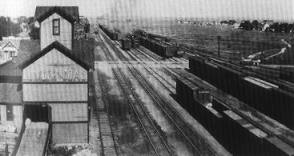 At that point,
North Platte had about 25 buildings and 300 residents,
but by fall the railroad completed its roundhouse and
other supportive structures. With good jobs available,
the town put down roots and began to take on a
permanent appearance. The first school opened in the
summer of 1868. Law and order came in the fall when
Peniston was awarded a contract to build a county
jail. By 1869 there was a courthouse, a bank, four
churches, many stores and shops, a land office, and
three newspapers.
At that point,
North Platte had about 25 buildings and 300 residents,
but by fall the railroad completed its roundhouse and
other supportive structures. With good jobs available,
the town put down roots and began to take on a
permanent appearance. The first school opened in the
summer of 1868. Law and order came in the fall when
Peniston was awarded a contract to build a county
jail. By 1869 there was a courthouse, a bank, four
churches, many stores and shops, a land office, and
three newspapers.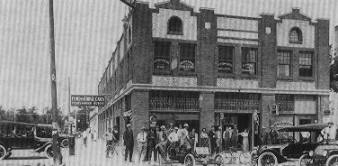 During its
first decade, North Platte was also the end of the
Texas cattle trail. It was said that during the summer
and fall there were so many longhorns tramping through
town to the railroad stockyards that it was unsafe to
be afoot in the streets.
During its
first decade, North Platte was also the end of the
Texas cattle trail. It was said that during the summer
and fall there were so many longhorns tramping through
town to the railroad stockyards that it was unsafe to
be afoot in the streets. In 1890
native-born William Jeffers quit school to become a
"call boy" for the Union Pacific. (Before telephones,
the dispatcher sent a boy to tell the crewmen when to
report to take their trains out.) During the next 47
years Bill rose from the company's lowest paid jobs to
its top position, president of the great Union Pacific
system. By 1941 the UP was using the "Big Boys," the
world's largest steam locomotives, on his road. In the
1950s they replaced the huge engines with faster, more
efficient diesel-electric engines needing neither
immense quantities of water nor long servicing periods
between runs. It has now been many years since the
melodious whistle of a steam engine has regularly been
heard in the valley of the Platte. (Occasional visits
in the past two decades by the last UP big engine have
thrilled hundreds with its beautiful whistle and
pulsating steam mechanism.)
In 1890
native-born William Jeffers quit school to become a
"call boy" for the Union Pacific. (Before telephones,
the dispatcher sent a boy to tell the crewmen when to
report to take their trains out.) During the next 47
years Bill rose from the company's lowest paid jobs to
its top position, president of the great Union Pacific
system. By 1941 the UP was using the "Big Boys," the
world's largest steam locomotives, on his road. In the
1950s they replaced the huge engines with faster, more
efficient diesel-electric engines needing neither
immense quantities of water nor long servicing periods
between runs. It has now been many years since the
melodious whistle of a steam engine has regularly been
heard in the valley of the Platte. (Occasional visits
in the past two decades by the last UP big engine have
thrilled hundreds with its beautiful whistle and
pulsating steam mechanism.)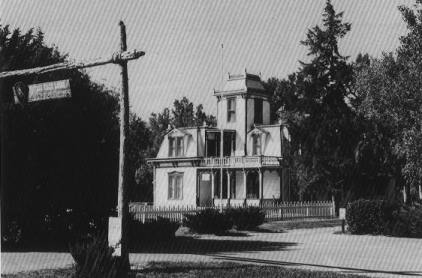 Since 1966
North Platte has added a two-year junior college to
the educational opportunities available in the city.
In 1968 a voc-tech college was also established. In
1986-87 the enrollment in these two facilities was
2,200.
Since 1966
North Platte has added a two-year junior college to
the educational opportunities available in the city.
In 1968 a voc-tech college was also established. In
1986-87 the enrollment in these two facilities was
2,200. Our town is
one of Nebraska's "big 12 towns." It has a mayor-city
council government. The police and fire departments
employ nearly 60 persons. Nearly 2,400 students are
educated in the nine elementary schools, and
approximately 1,000 in the two junior highs, and the
senior high school. North Platte has 41 churches, 27
motels, a 130-bed hospital, two licensed nursing
homes, and a retirement center. The "Daily Telegraph"
newspaper, six radio stations, and a TV station
broadcast news to a large area. In addition to the
large rodeo arena, North Platte has a large recreation
complex, many parks, golf courses, swimming pools, and
a five-acre county museum complex. The "main artery"
across Nebraska, Interstate Highway 80, intersects
with Highway 83, making North Platte a major
crossroads on the prairie.
Our town is
one of Nebraska's "big 12 towns." It has a mayor-city
council government. The police and fire departments
employ nearly 60 persons. Nearly 2,400 students are
educated in the nine elementary schools, and
approximately 1,000 in the two junior highs, and the
senior high school. North Platte has 41 churches, 27
motels, a 130-bed hospital, two licensed nursing
homes, and a retirement center. The "Daily Telegraph"
newspaper, six radio stations, and a TV station
broadcast news to a large area. In addition to the
large rodeo arena, North Platte has a large recreation
complex, many parks, golf courses, swimming pools, and
a five-acre county museum complex. The "main artery"
across Nebraska, Interstate Highway 80, intersects
with Highway 83, making North Platte a major
crossroads on the prairie.